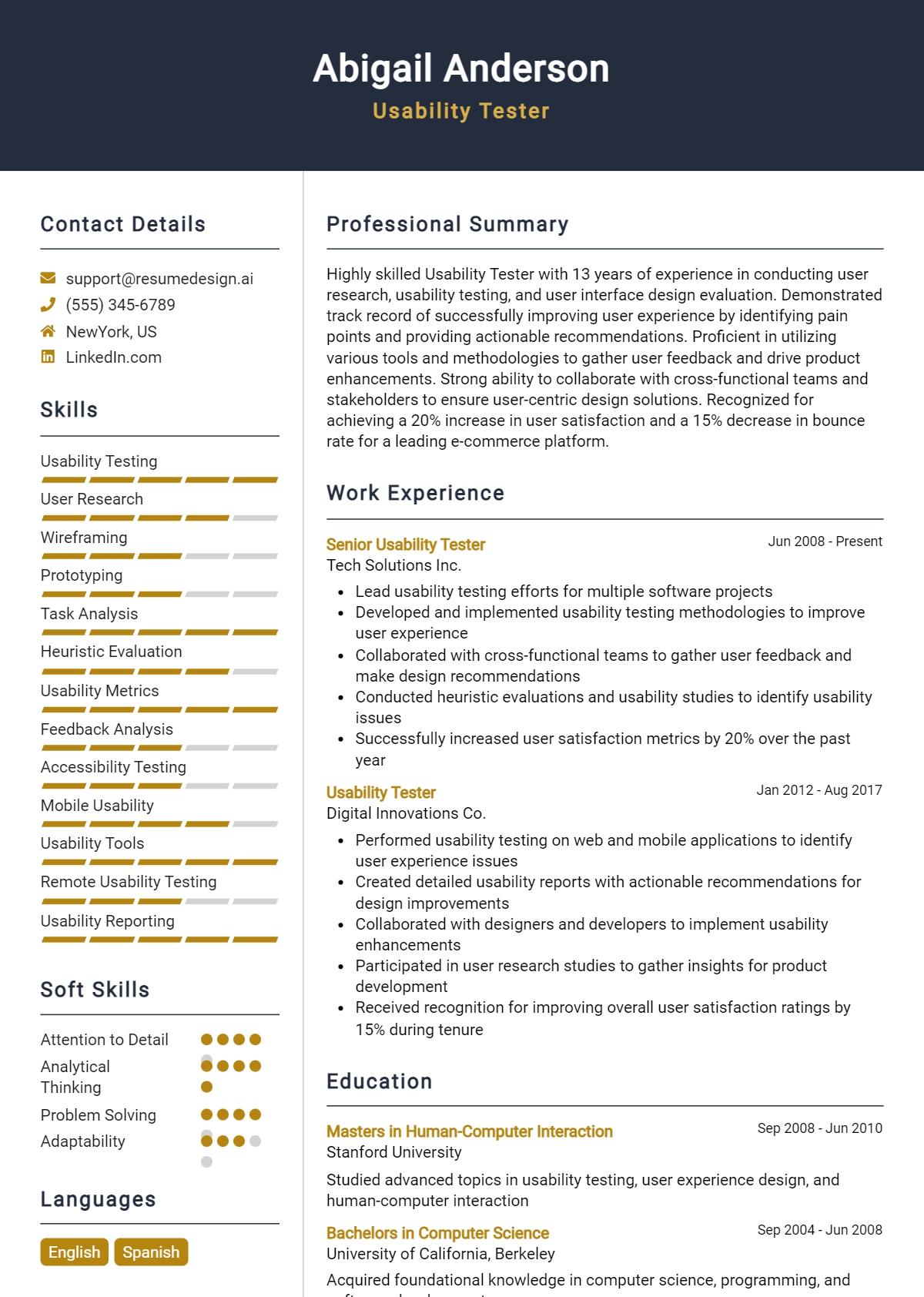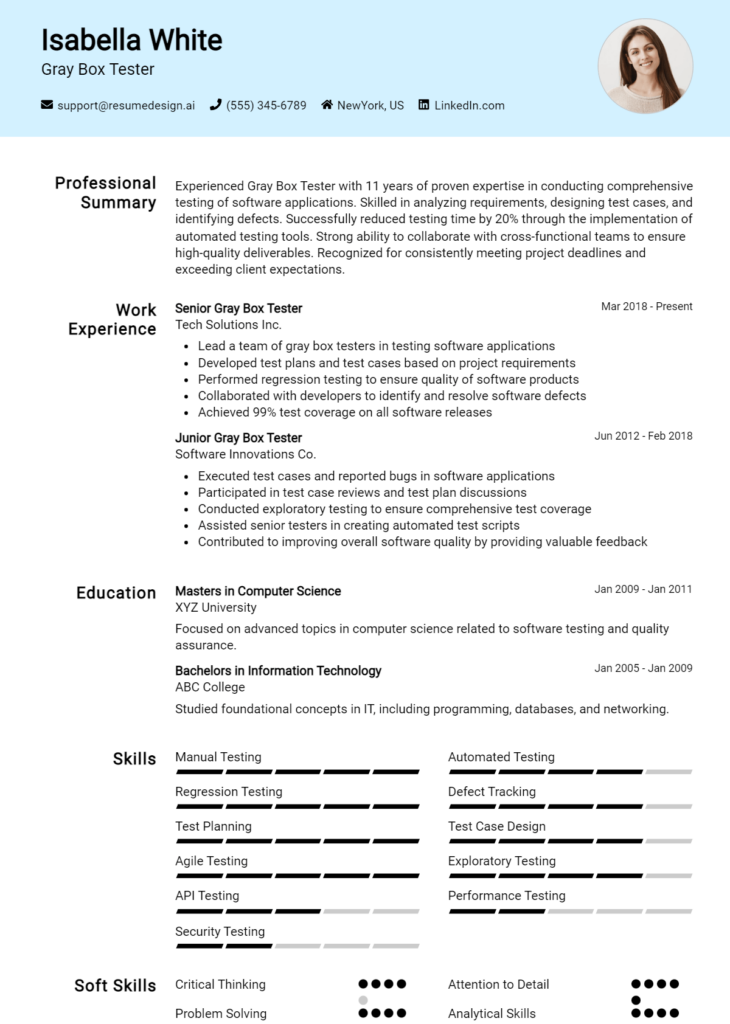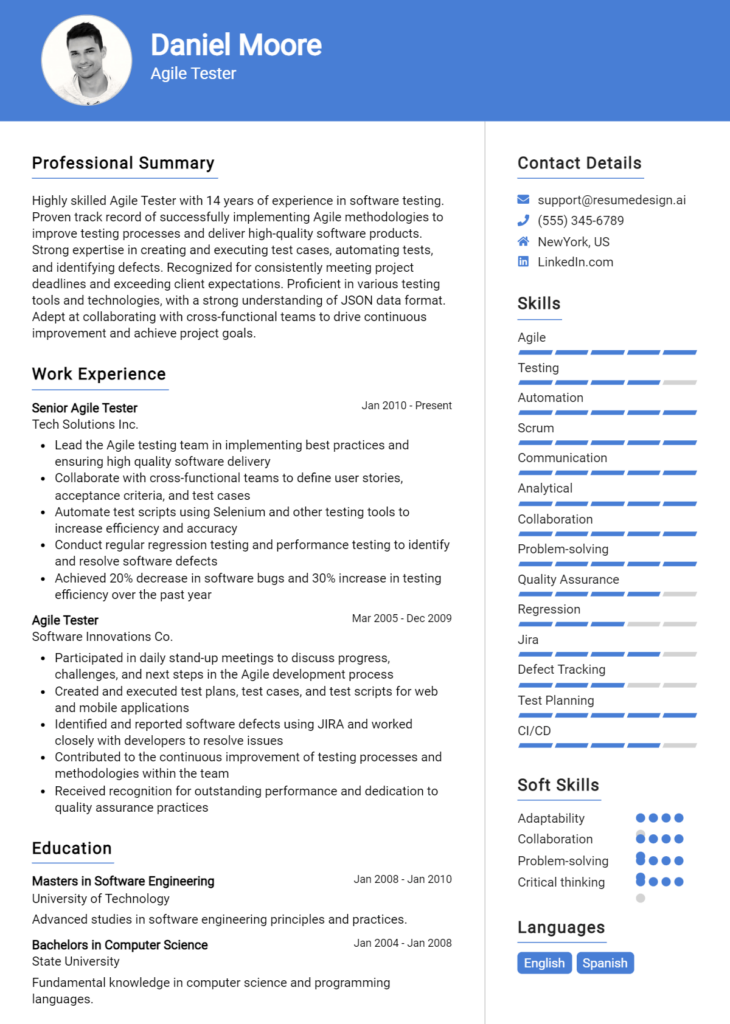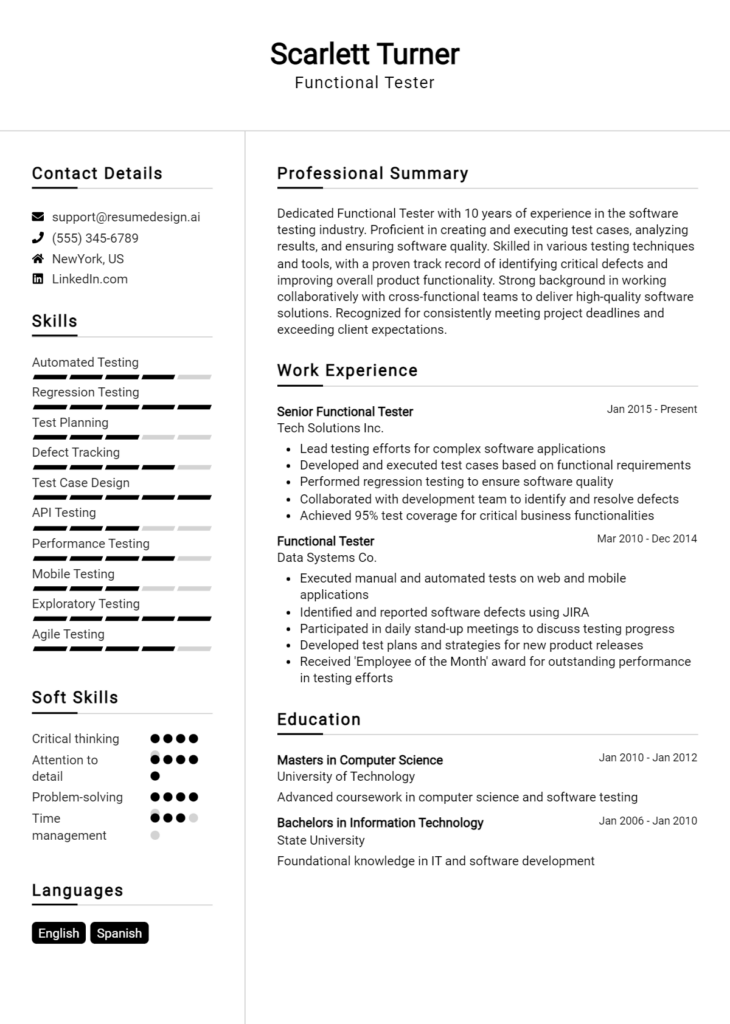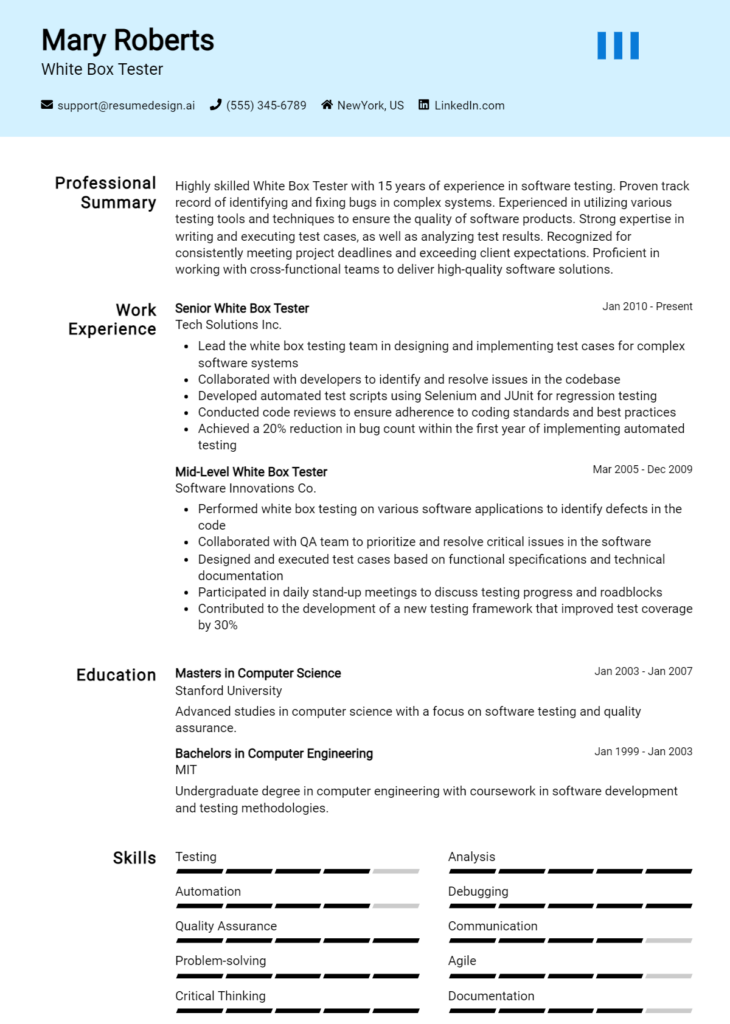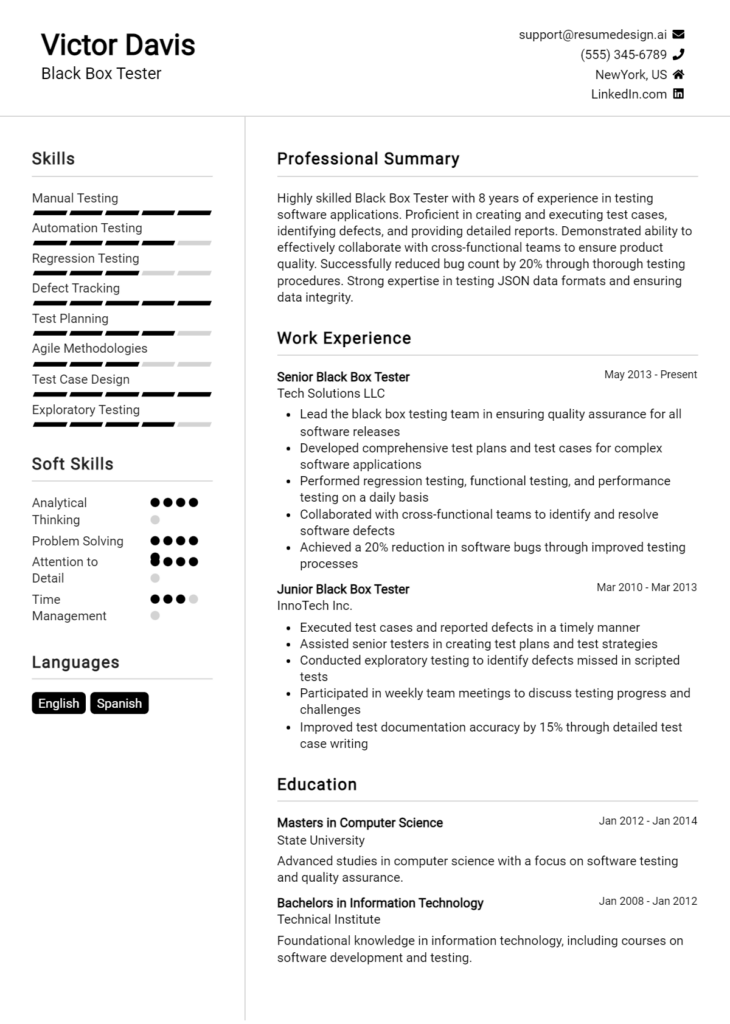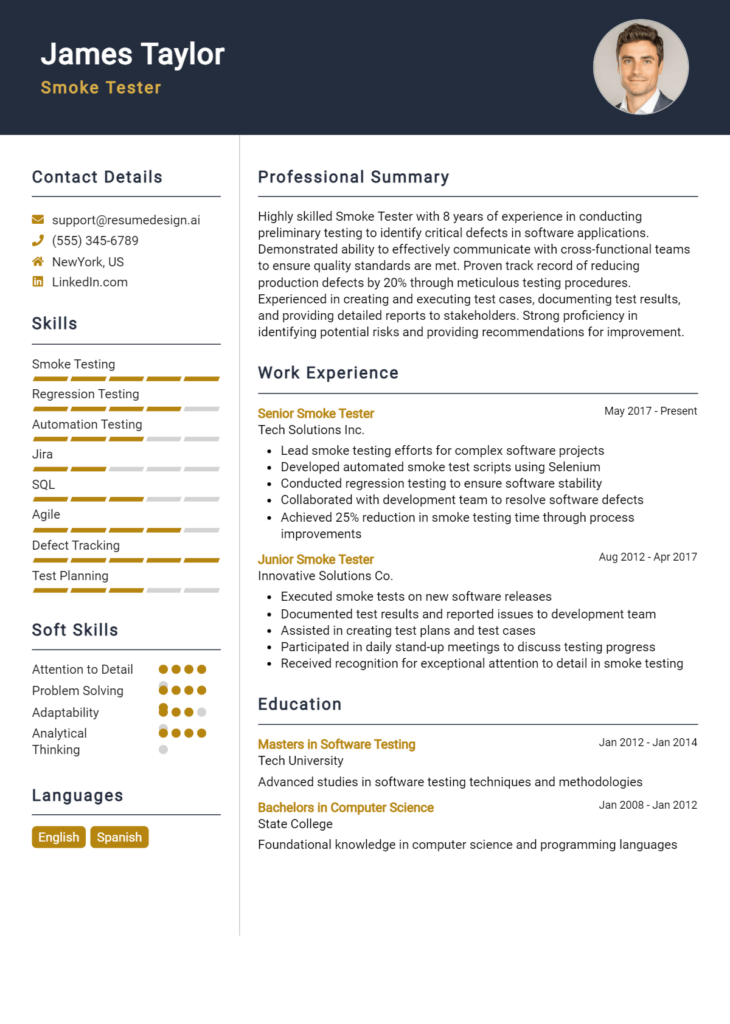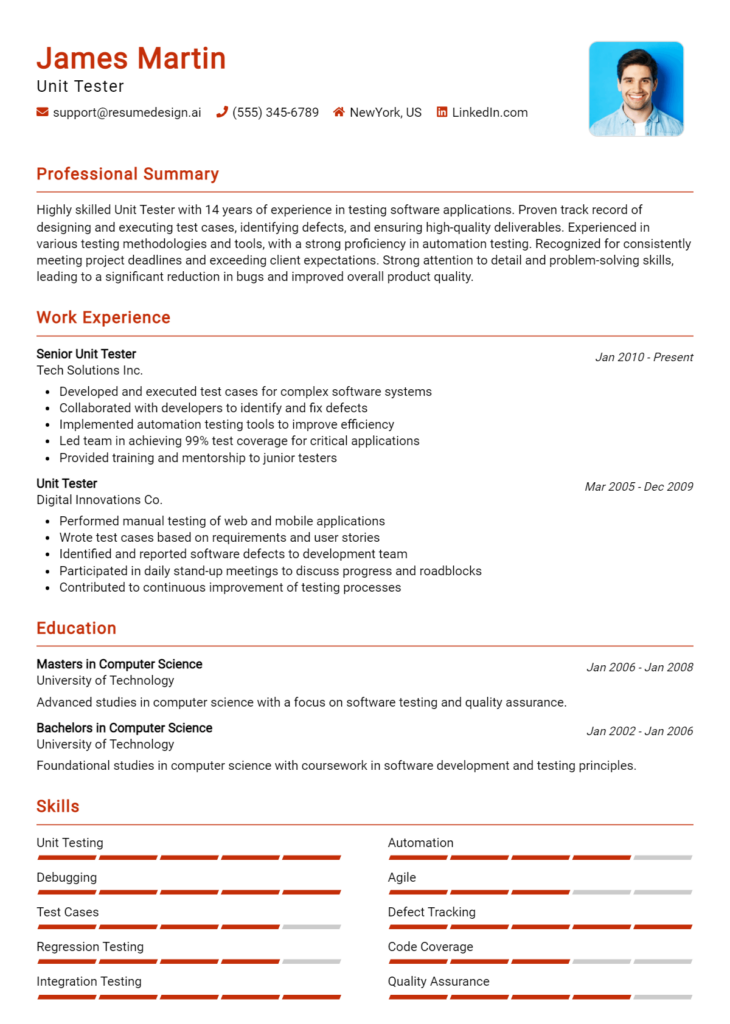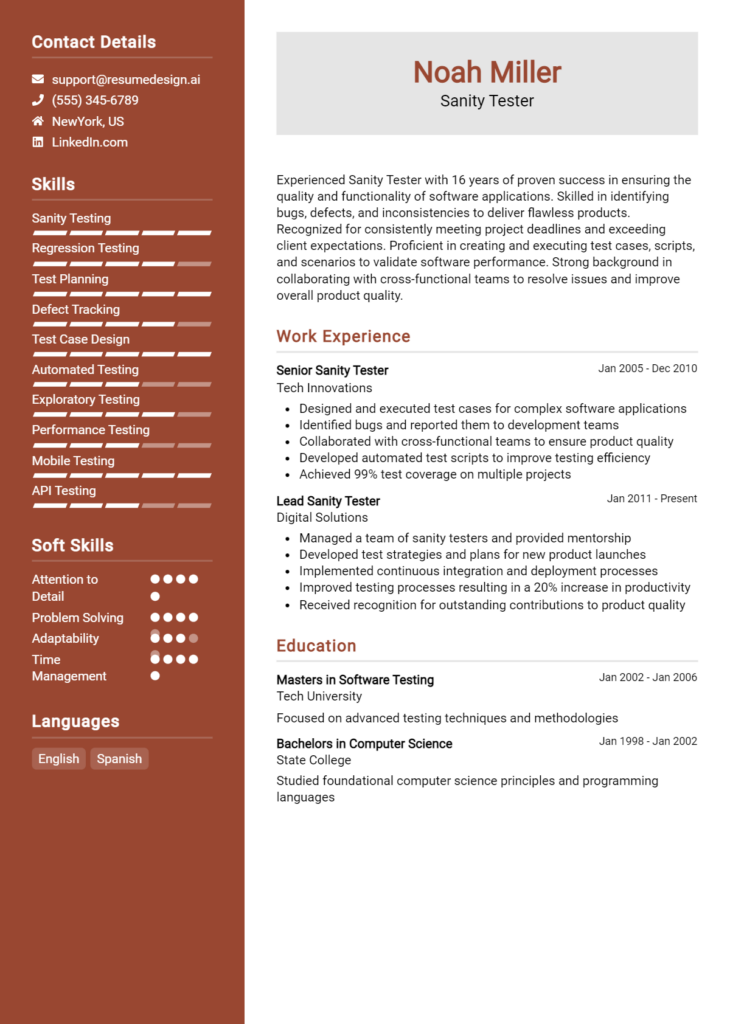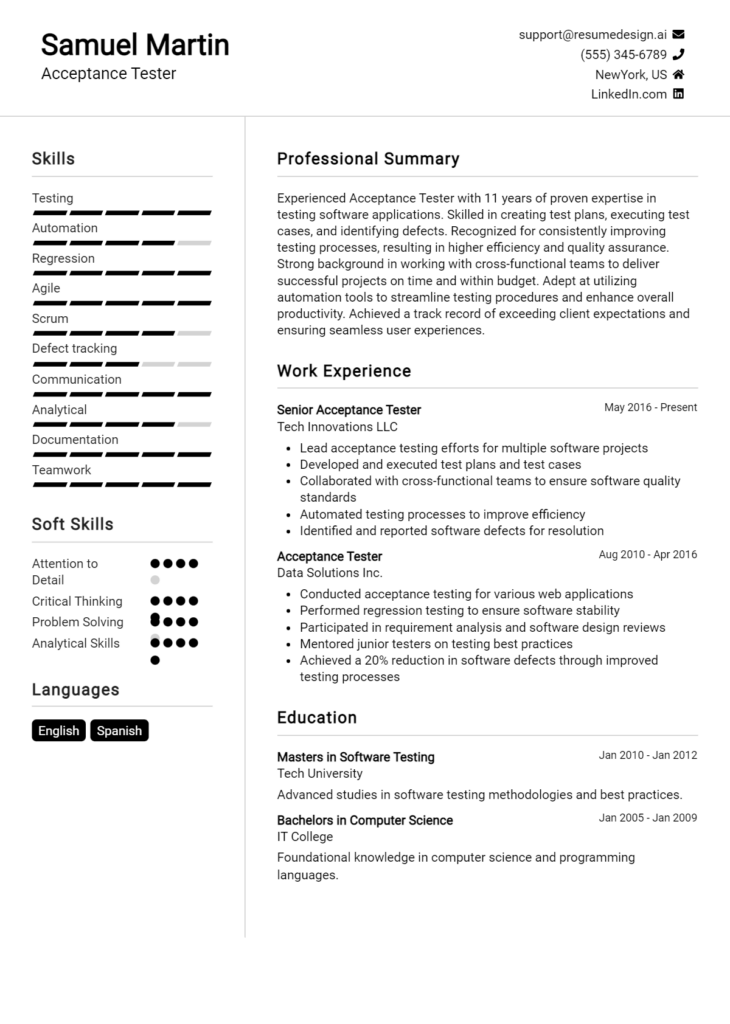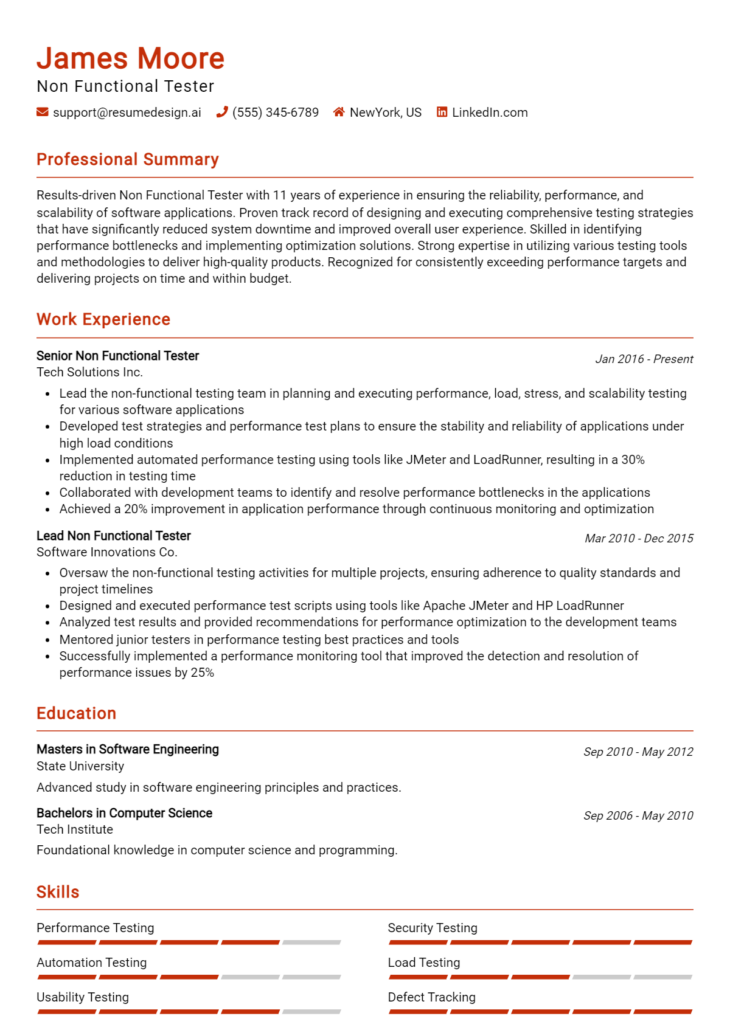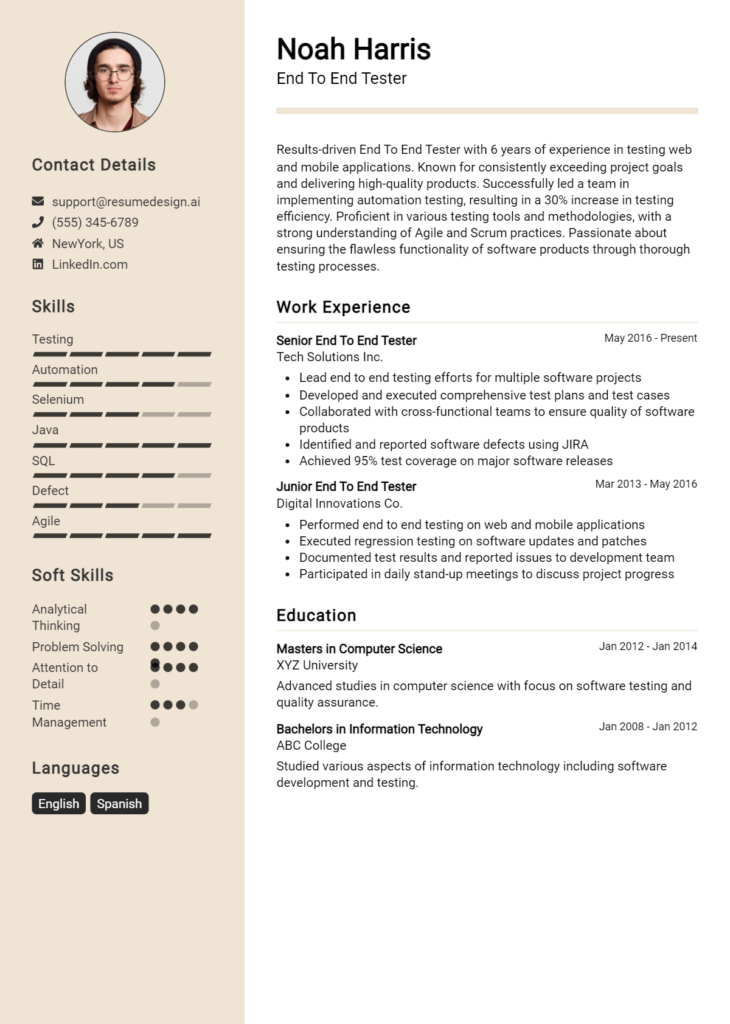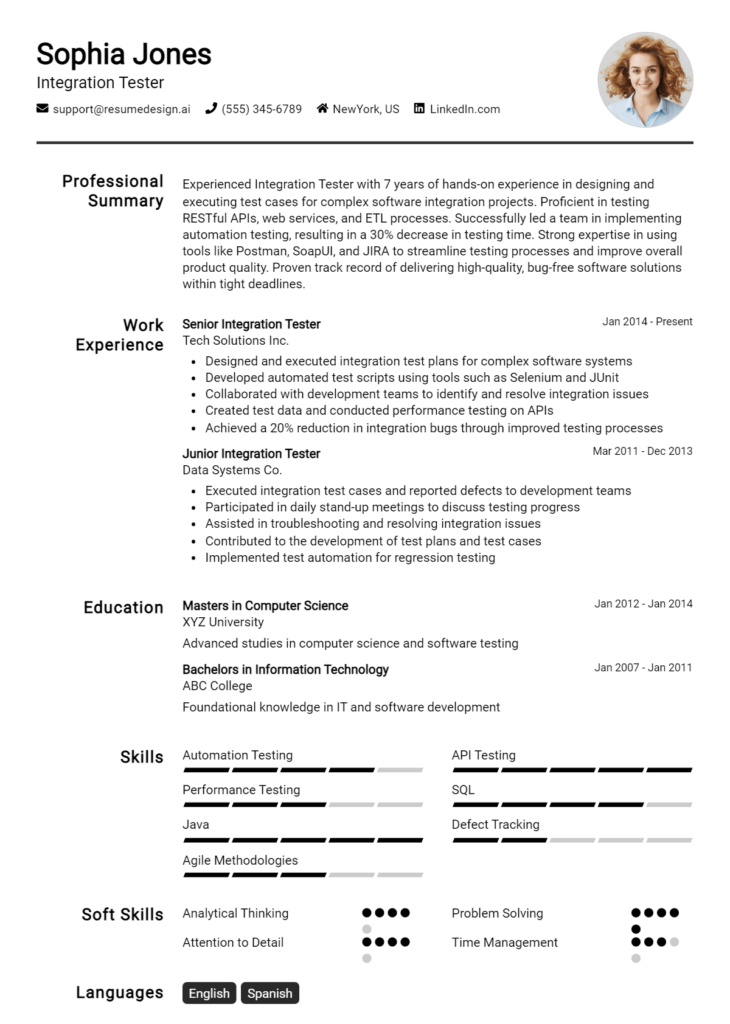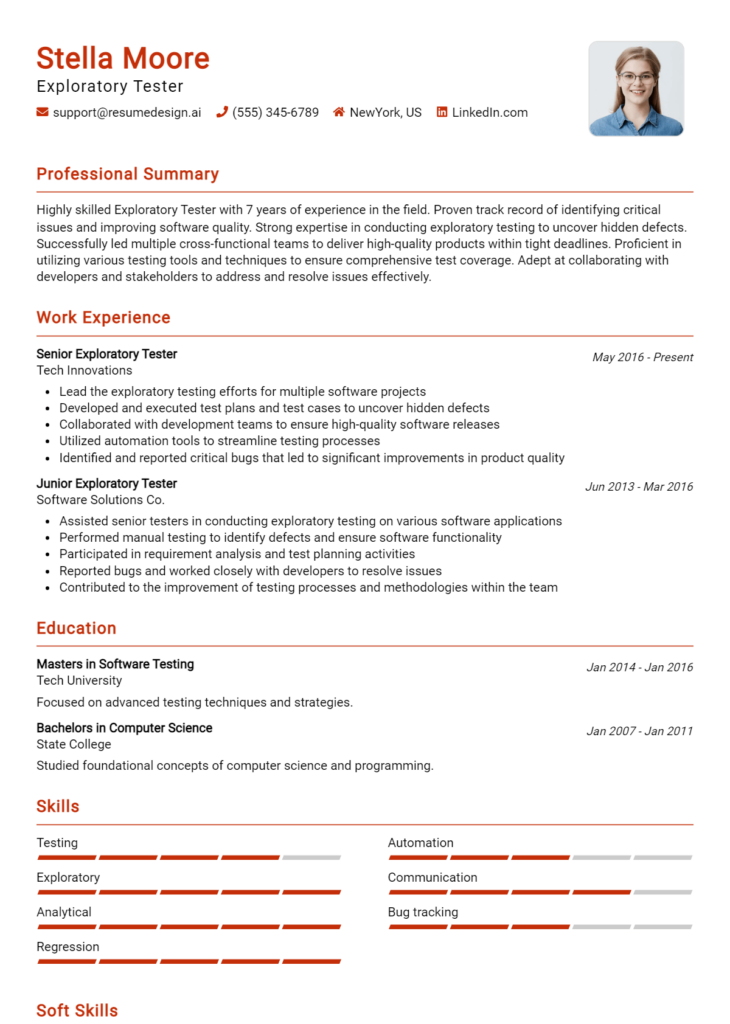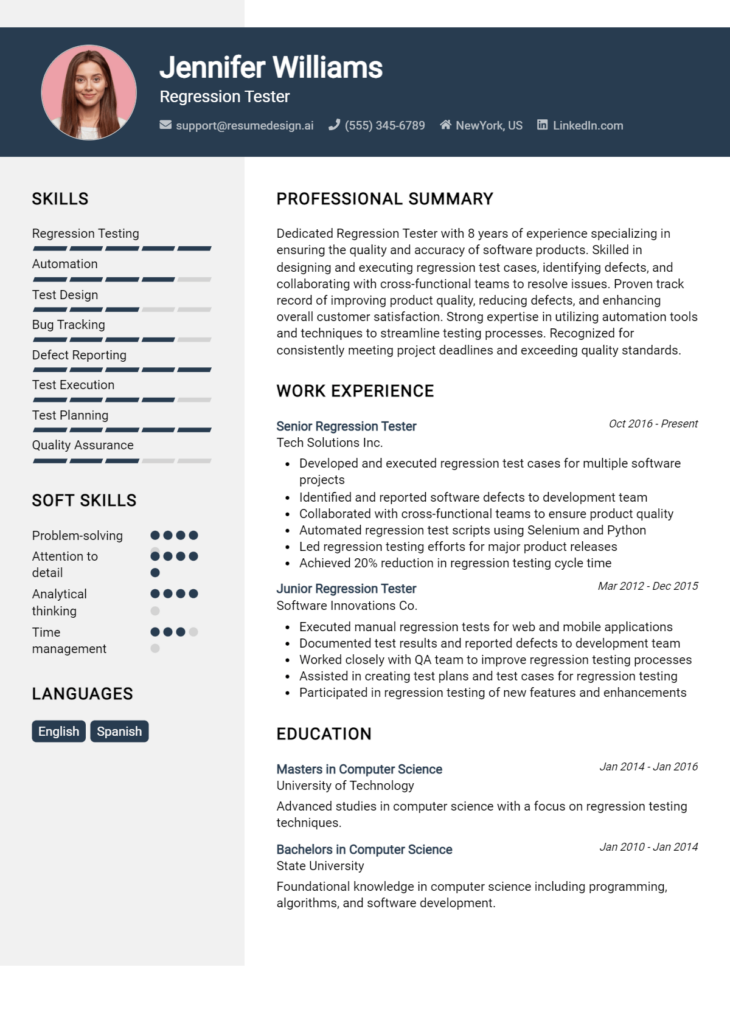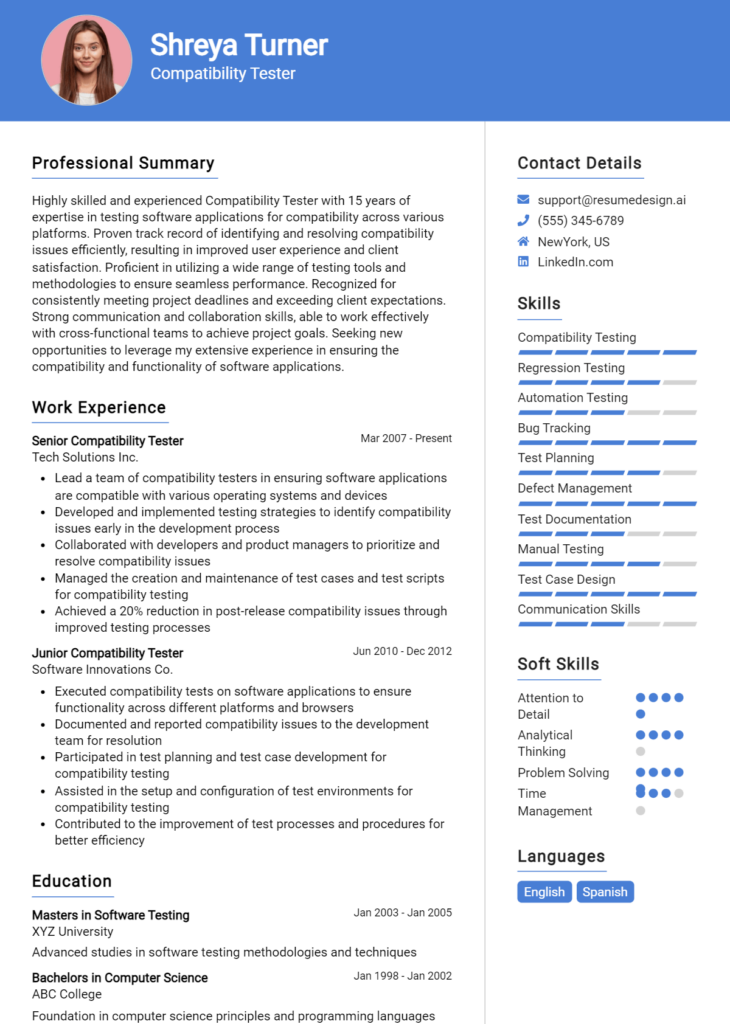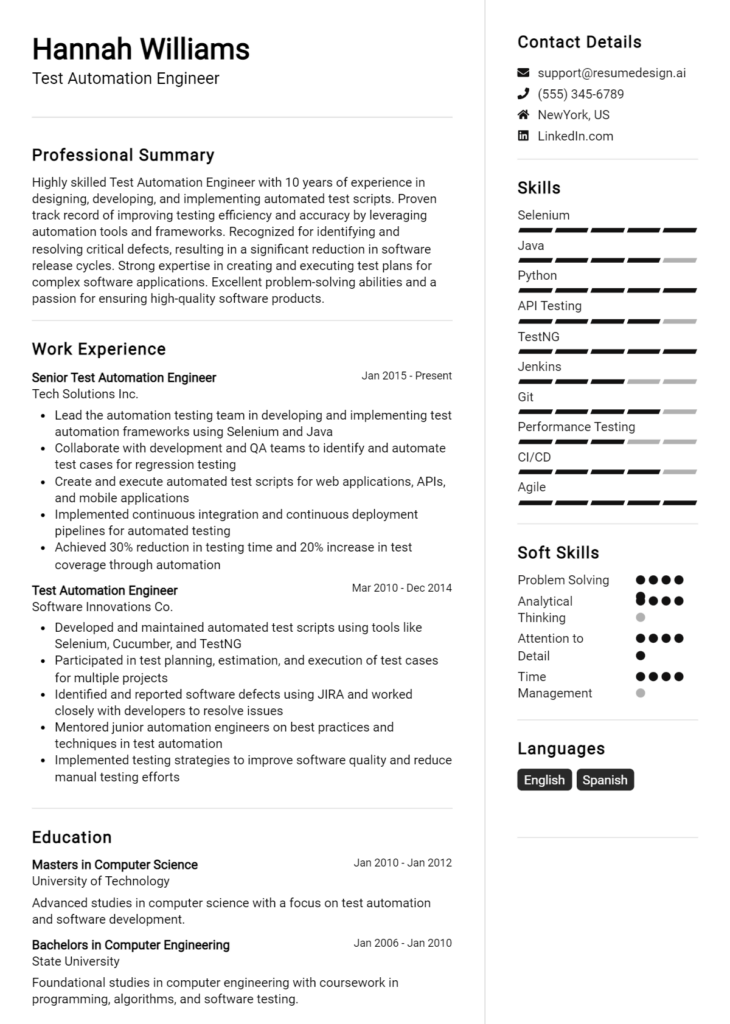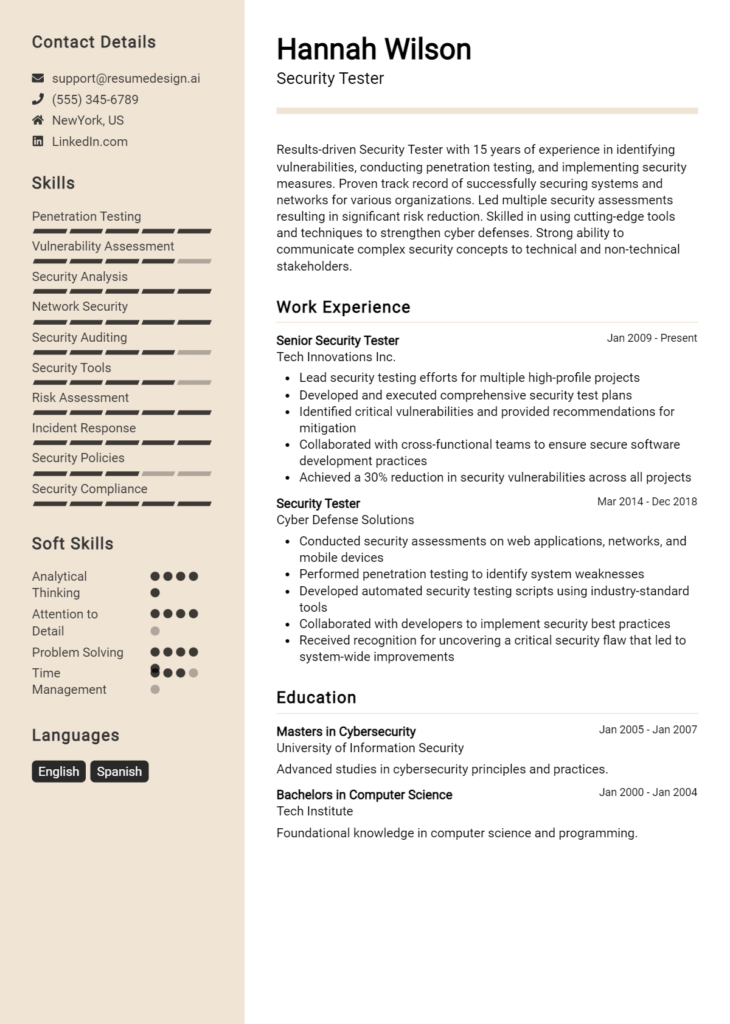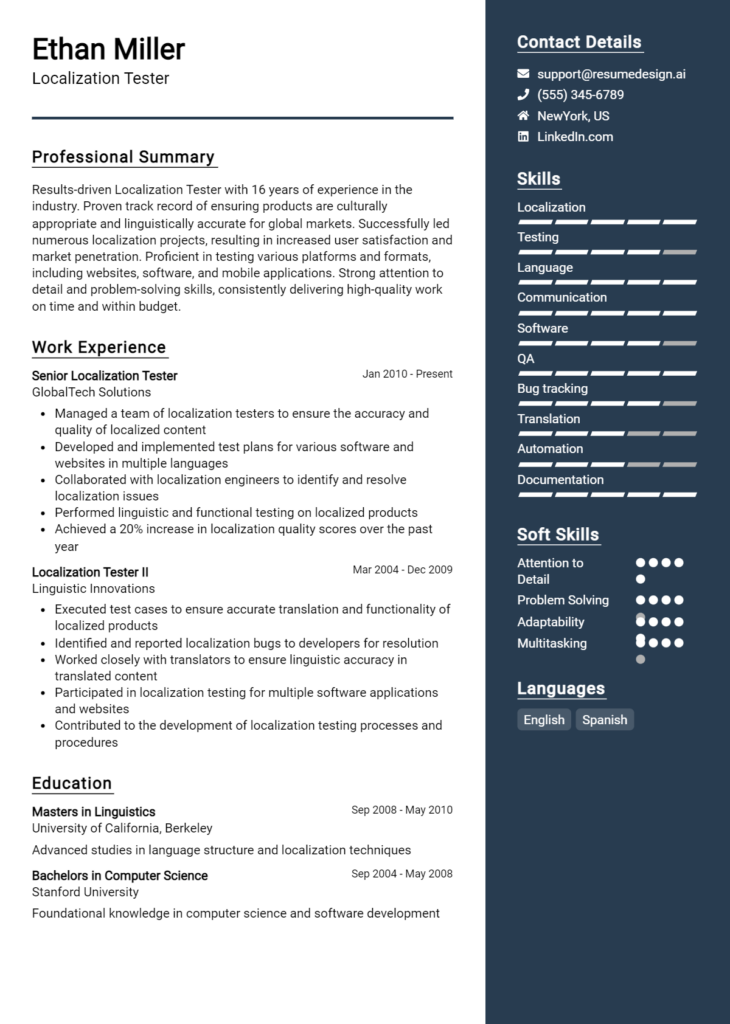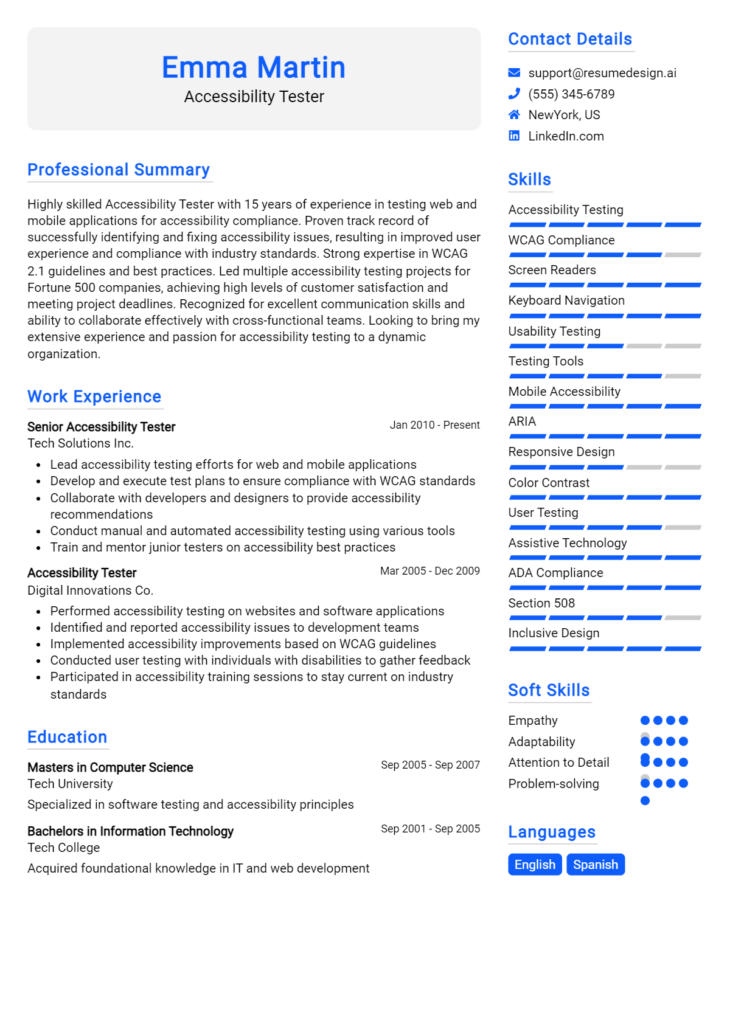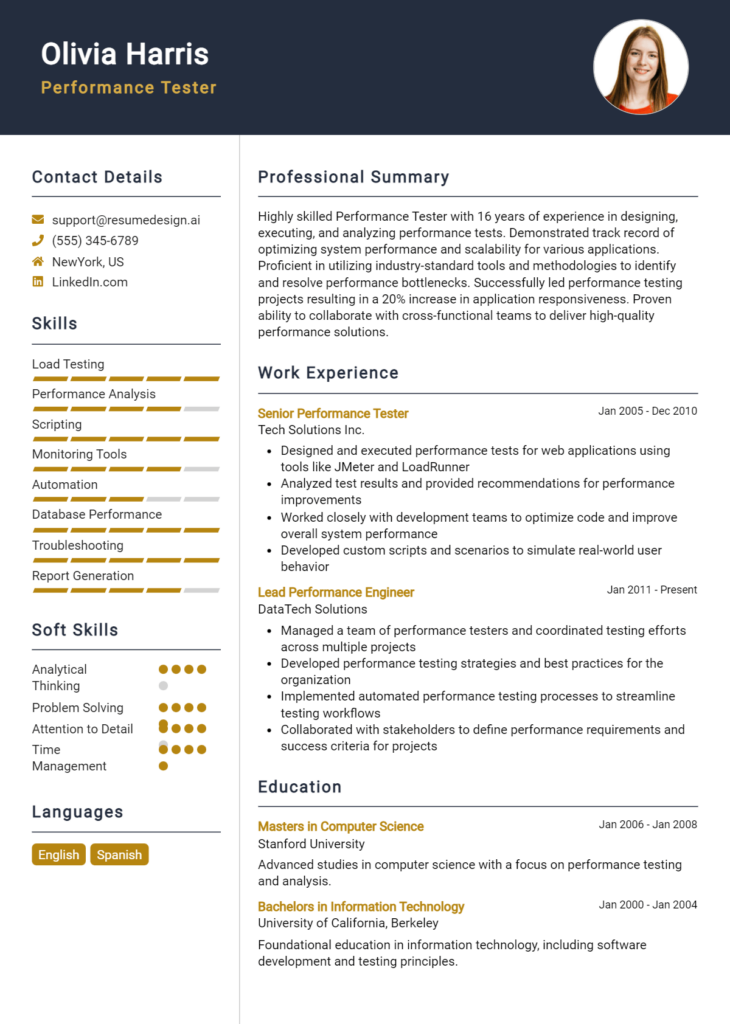Usability Tester Core Responsibilities
A Usability Tester plays a crucial role in enhancing user experience by evaluating products, interfaces, and applications. Their core responsibilities include conducting user research, creating test plans, facilitating usability tests, and analyzing feedback. This role requires strong technical skills, operational insight, and adept problem-solving abilities to bridge the gap between design, development, and marketing teams. Effective communication and analytical skills contribute significantly to achieving organizational goals, making a well-structured resume invaluable in showcasing these qualifications.
Common Responsibilities Listed on Usability Tester Resume
- Conduct user research and gather user feedback through surveys and interviews.
- Create and implement usability test plans to evaluate product performance.
- Facilitate usability testing sessions with real users.
- Analyze test results to identify usability issues and recommend improvements.
- Collaborate with design and development teams to enhance user interfaces.
- Document findings and prepare detailed reports for stakeholders.
- Stay updated on industry trends and usability best practices.
- Utilize analytics tools to track user behavior and engagement.
- Present usability findings to cross-functional teams and management.
- Assist in the design of user-friendly prototypes and wireframes.
- Support the implementation of user-centric design principles.
High-Level Resume Tips for Usability Tester Professionals
In today's competitive job market, a well-crafted resume is essential for Usability Tester professionals aiming to make a lasting first impression on potential employers. Your resume serves as a personal marketing tool that not only showcases your skills and achievements but also reflects your understanding of user experience principles. As the first point of contact between you and a hiring manager, it is crucial that your resume stands out and effectively communicates your qualifications. This guide will provide practical and actionable resume tips specifically tailored for Usability Tester professionals, helping you to create a compelling document that resonates with recruiters.
Top Resume Tips for Usability Tester Professionals
- Tailor your resume to each job description by incorporating relevant keywords and phrases that align with the specific requirements of the position.
- Highlight your relevant experience in usability testing, including specific projects where you contributed to user research, testing, and analysis.
- Quantify your achievements by using metrics, such as the percentage of usability improvement or the number of tests conducted, to demonstrate the impact of your work.
- Showcase your familiarity with usability testing tools and software, such as UserTesting, Lookback, or Optimal Workshop, to highlight your technical skills.
- Include a section on your education and certifications, particularly any relevant degrees or courses in human-computer interaction, UX design, or usability testing.
- Emphasize your ability to analyze user feedback and translate it into actionable design recommendations, showcasing your analytical skills.
- Incorporate soft skills that are vital for a Usability Tester, such as communication, collaboration, and problem-solving, to illustrate your overall fit for the role.
- Keep your resume concise and focused, ideally one page, ensuring that every word adds value and relevance to your application.
- Use a clean, professional layout with easy-to-read fonts and clear headings to improve readability and make a strong visual impression.
By implementing these tips, you can significantly enhance your resume and increase your chances of landing a job in the Usability Tester field. A targeted and well-structured resume will not only showcase your unique skills and experiences but also demonstrate your commitment to delivering exceptional user experiences, making you a more attractive candidate to potential employers.
Why Resume Headlines & Titles are Important for Usability Tester
In the competitive landscape of job applications, a Usability Tester must prioritize the crafting of a compelling resume headline or title. This concise phrase serves as the first impression for hiring managers, summarizing a candidate's key qualifications and expertise in usability testing. A strong headline can immediately capture attention, making the applicant stand out among a sea of resumes. It should be relevant, impactful, and directly related to the job being applied for, effectively encapsulating the individual's skills and experiences in a manner that encourages further reading.
Best Practices for Crafting Resume Headlines for Usability Tester
- Keep it concise—ideally under 10 words.
- Use role-specific keywords relevant to usability testing.
- Highlight your most impressive skills or accomplishments.
- Avoid vague terms; be specific about your expertise.
- Incorporate industry-standard terminology that resonates with hiring managers.
- Showcase your unique selling points that differentiate you from other candidates.
- Tailor your headline for each job application to align with the job description.
- Use action-oriented language to convey confidence and capability.
Example Resume Headlines for Usability Tester
Strong Resume Headlines
"Experienced Usability Tester with 5+ Years in E-commerce Optimization"
“Certified Usability Specialist Focused on User-Centric Design Principles”
“Detail-Oriented Usability Tester Committed to Enhancing User Experience Through Data-Driven Insights”
Weak Resume Headlines
“Looking for a Job in Testing”
“Usability Tester with Some Experience”
The strong headlines are effective because they clearly communicate specific skills and experiences that are directly relevant to the Usability Tester role, making them immediately appealing to hiring managers. They emphasize qualifications and accomplishments while utilizing industry-specific language. Conversely, the weak headlines fail to impress due to their vagueness and lack of detail; they do not provide any insight into the candidate's capabilities or unique contributions, making it difficult for hiring managers to see the value they could bring to the team.
Writing an Exceptional Usability Tester Resume Summary
A resume summary is a critical component for a Usability Tester, as it serves as the first impression for potential employers. This brief section allows candidates to highlight their key skills, relevant experience, and notable accomplishments in a way that captures the attention of hiring managers quickly. An exceptional summary should be concise yet impactful, tailored specifically to the job being applied for, and designed to showcase how the candidate's expertise aligns with the organization's needs. By providing a snapshot of their capabilities, candidates can effectively differentiate themselves from the competition and entice hiring managers to delve deeper into their resumes.
Best Practices for Writing a Usability Tester Resume Summary
- Quantify Achievements: Use numbers and metrics to demonstrate the impact of your work.
- Focus on Skills: Highlight your key competencies that are relevant to usability testing, such as user research, analysis, and software proficiency.
- Tailor the Summary: Customize your summary to align with the specific job description and company culture.
- Highlight Relevant Experience: Emphasize past roles or projects that directly relate to usability testing.
- Use Action Words: Begin sentences with strong action verbs to convey confidence and proactivity.
- Keep it Concise: Aim for 3-5 sentences that pack a punch without overwhelming the reader.
- Showcase Soft Skills: Mention interpersonal skills such as communication and collaboration, which are crucial for usability testing.
- Maintain Professional Tone: Ensure the summary reflects a professional demeanor appropriate for the industry.
Example Usability Tester Resume Summaries
Strong Resume Summaries
Detail-oriented Usability Tester with over 5 years of experience in conducting user research and usability testing for web and mobile applications. Successfully identified usability issues that improved user satisfaction scores by 40% in multiple projects.
Results-driven Usability Tester skilled in A/B testing and usability analysis, having led a project that reduced user task completion time by 30%. Proficient in using tools like UserTesting and Optimal Workshop to gather actionable insights.
Dynamic Usability Tester with a strong background in human-computer interaction and user-centered design. Developed wireframes and prototypes that increased user engagement by 25%, significantly enhancing product usability.
Experienced Usability Tester with a proven track record of collaborating with cross-functional teams to deliver user-friendly solutions. Played a key role in a redesign project that boosted the Net Promoter Score (NPS) by 15 points.
Weak Resume Summaries
Usability Tester with some experience looking for a new opportunity. I am interested in helping companies improve their software.
Enthusiastic individual with knowledge in usability testing and a desire to learn more about the field.
The strong resume summaries are considered effective because they provide specific, quantifiable achievements and relevant skills that directly relate to the usability testing role. They illustrate the candidate's impact through measurable results and demonstrate a clear understanding of the field. In contrast, the weak resume summaries lack detail and specificity, offering vague statements that do not convey the candidate's capabilities or the value they can bring to a potential employer. This lack of focus makes them less compelling to hiring managers seeking qualified candidates.
Work Experience Section for Usability Tester Resume
The work experience section of a Usability Tester resume is crucial as it provides a detailed account of the candidate's professional journey, showcasing their technical skills and competencies in usability testing. This section not only highlights the individual’s ability to manage teams effectively but also illustrates their capacity to deliver high-quality products that enhance user experience. By quantifying achievements and aligning their experience with industry standards, candidates can demonstrate their value to potential employers and differentiate themselves in a competitive job market.
Best Practices for Usability Tester Work Experience
- Clearly articulate your role in usability testing projects and methodologies utilized.
- Quantify your achievements with metrics, such as improved user satisfaction scores or reduced task completion time.
- Highlight technical skills relevant to usability testing, such as proficiency with testing software or analytical tools.
- Emphasize collaboration with cross-functional teams, including designers and developers, to improve product quality.
- Detail specific usability testing techniques used, like A/B testing or heuristic evaluations.
- Showcase any leadership roles taken during projects, such as leading a testing team or managing stakeholder communications.
- Align your experience with industry standards and best practices to demonstrate your knowledge of current trends.
Example Work Experiences for Usability Tester
Strong Experiences
- Led a usability testing project that resulted in a 40% increase in user satisfaction scores by implementing actionable changes based on feedback.
- Managed a cross-functional team of 5 members to conduct A/B testing, which optimized the user interface and reduced task completion time by 30%.
- Utilized advanced usability testing tools to analyze user interactions, identifying pain points that improved the overall user experience by 25%.
- Coordinated usability studies with over 100 participants, providing insights that directly influenced the redesign of a key product feature.
Weak Experiences
- Participated in usability testing projects.
- Helped improve user experience.
- Worked with a team on various tasks.
- Conducted tests and collected feedback.
The examples categorized as strong experiences are considered effective because they provide specific, quantifiable outcomes that demonstrate the candidate's impact on usability improvements and their technical leadership in projects. In contrast, the weak experiences lack detail and fail to convey the candidate's direct contributions or achievements, making them less compelling to potential employers.
Education and Certifications Section for Usability Tester Resume
The education and certifications section of a Usability Tester resume plays a critical role in showcasing a candidate's academic foundation and commitment to professional development. It not only highlights the formal education that equips individuals with essential knowledge and skills but also emphasizes industry-relevant certifications that demonstrate expertise in usability testing methodologies and principles. By detailing relevant coursework, certifications, and specialized training, candidates can significantly enhance their credibility and alignment with the job requirements, reassuring potential employers of their competency in the field.
Best Practices for Usability Tester Education and Certifications
- Include degrees relevant to usability testing, such as Human-Computer Interaction, Psychology, or Design.
- Highlight industry-recognized certifications like Certified Usability Analyst (CUA) or Certified User Experience Professional (CUXP).
- Provide specific coursework that relates to usability testing or user experience design.
- List any workshops or training sessions attended that focus on usability testing tools and techniques.
- Utilize a clear and organized format to enhance readability and professionalism.
- Keep the section updated and remove outdated or irrelevant qualifications.
- Emphasize continuous learning through online courses or webinars related to usability and user experience.
- Consider including any relevant research projects or thesis topics that relate to usability testing.
Example Education and Certifications for Usability Tester
Strong Examples
- Bachelor of Science in Human-Computer Interaction, University of California, 2021
- Certified Usability Analyst (CUA), Human Factors International, 2022
- Coursework in User Experience Design and Usability Testing, Online UX Design Bootcamp, 2023
- Certification in Interaction Design, Nielsen Norman Group, 2023
Weak Examples
- Associate Degree in General Studies, Community College, 2019
- Certification in Microsoft Office Applications, 2020
- High School Diploma, 2018
- Outdated certification in Basic HTML, 2015
The strong examples are considered effective because they directly relate to the field of usability testing and demonstrate relevant knowledge and skills that align with the role. They showcase degrees and certifications from recognized institutions that emphasize expertise in user experience and usability principles. In contrast, the weak examples highlight qualifications that are either too general, outdated, or unrelated to usability testing, which diminishes the candidate's perceived competency in the field and may fail to attract the attention of potential employers.
Top Skills & Keywords for Usability Tester Resume
In the competitive field of usability testing, having the right skills is crucial for standing out in a crowded job market. A well-crafted resume that highlights both hard and soft skills can significantly enhance a candidate's chances of securing an interview. Usability testers are responsible for evaluating the user experience of products and services, making it essential to showcase a blend of technical knowledge and interpersonal abilities. By strategically emphasizing these skills, candidates can demonstrate their capacity to not only assess usability issues but also collaborate effectively with design and development teams.
Top Hard & Soft Skills for Usability Tester
Soft Skills
- Attention to Detail
- Analytical Thinking
- Effective Communication
- Problem-Solving
- Empathy
- Collaboration
- Adaptability
- Time Management
- Critical Thinking
- User-Centric Approach
Hard Skills
- Knowledge of Usability Testing Methods
- Proficiency in UX Design Tools (e.g., Sketch, Figma)
- Familiarity with A/B Testing
- Expertise in Data Analysis and Interpretation
- Understanding of User Research Techniques
- Experience with Accessibility Standards
- Knowledge of HTML/CSS
- Proficiency in Survey Tools (e.g., SurveyMonkey, Qualtrics)
- Familiarity with Analytics Tools (e.g., Google Analytics)
- Ability to Create User Personas and Scenarios
By including these skills in your resume, in conjunction with relevant work experience, you can present a compelling case to potential employers about your qualifications as a usability tester.
Stand Out with a Winning Usability Tester Cover Letter
As a dedicated Usability Tester with a passion for enhancing user experiences, I am excited to apply for the position at [Company Name]. With a solid background in user research, usability testing methodologies, and a keen eye for detail, I have successfully contributed to projects that prioritize user-centric design. My experience in conducting usability tests, analyzing user feedback, and collaborating with cross-functional teams has equipped me with the skills necessary to identify pain points and recommend actionable improvements that enhance overall usability.
In my previous role at [Previous Company Name], I was responsible for designing and executing usability tests for various digital products, ranging from websites to mobile applications. I utilized a variety of testing methods, including remote testing and A/B testing, to gather valuable insights into user behavior. By synthesizing this data into comprehensive reports, I effectively communicated findings to design and development teams, resulting in a [specific percentage or outcome] improvement in user satisfaction scores. My ability to bridge the gap between technical requirements and user needs has been crucial in driving successful product iterations.
I am particularly drawn to [Company Name] because of its commitment to innovation and user experience excellence. I admire your focus on creating intuitive products that not only meet user needs but also exceed expectations. I am eager to bring my expertise in usability testing and user advocacy to your team, ensuring that every product is thoroughly vetted for usability before it reaches the end-user. I am confident that my collaborative approach and problem-solving skills will make a positive impact on your projects.
Thank you for considering my application. I look forward to the opportunity to discuss how my skills and experiences align with the goals of [Company Name]. I am excited about the possibility of contributing to your team and helping to create exceptional user experiences that resonate with your audience.
Common Mistakes to Avoid in a Usability Tester Resume
When applying for a position as a Usability Tester, it's crucial to present a resume that showcases your skills and experience effectively. However, many candidates often overlook certain elements that can significantly impact their chances of landing an interview. Here are some common mistakes to avoid in your Usability Tester resume:
Vague Job Descriptions: Failing to provide specific details about your previous roles can leave potential employers uncertain about your capabilities. Instead, use clear examples that highlight your contributions and achievements.
Ignoring Relevant Skills: A common pitfall is not tailoring your resume to include the specific skills that are relevant to usability testing. Remember to emphasize skills such as user research, usability analysis, and experience with testing tools.
Lack of Quantifiable Achievements: Merely listing job responsibilities without quantifying your achievements can weaken your resume. Use metrics or specific outcomes from your testing projects to demonstrate your impact.
Overloading with Technical Jargon: While it's important to showcase your technical knowledge, overloading your resume with jargon can make it difficult for non-technical hiring managers to assess your suitability. Aim for a balance that is both informative and accessible.
Neglecting User-Centered Design Principles: Failing to mention your understanding of user-centered design can be a missed opportunity. Highlight your familiarity with usability principles and methodologies to show that you are aligned with industry standards.
Poor Formatting and Layout: A cluttered or unprofessional-looking resume can detract from your qualifications. Ensure that your resume is well-organized, easy to read, and visually appealing.
Not Including a Portfolio: Usability testing relies heavily on practical experience and results, so neglecting to include a link to your portfolio can hurt your application. Showcase your best work to provide tangible evidence of your skills.
Ignoring Soft Skills: Usability testing requires strong communication and empathy skills, yet many candidates focus solely on technical abilities. Be sure to highlight your soft skills that contribute to successful user interactions and stakeholder collaboration.
Conclusion
As we've explored, the role of a Usability Tester is crucial in ensuring that products are user-friendly and meet the needs of the end-user. Key responsibilities include evaluating user interfaces, conducting user research, and providing actionable feedback to improve overall usability. It’s essential for Usability Testers to possess strong analytical skills, attention to detail, and a solid understanding of user experience principles.
To stand out in this competitive field, having a well-crafted resume is vital. Your resume should highlight your relevant skills, experiences, and achievements in usability testing. Tailoring your resume to specifically reflect the demands of the job can significantly increase your chances of landing interviews.
Now is the perfect time to revisit and refine your Usability Tester Resume. Take advantage of the various resources available to you, including resume templates, which can help you format your resume professionally. If you're looking for a more hands-on approach, try the resume builder to create a customized resume effortlessly. Additionally, reviewing resume examples can provide you with inspiration and ideas on how to effectively showcase your qualifications. Don’t forget the importance of a compelling introduction—our cover letter templates can guide you in crafting a strong cover letter that complements your resume.
Take the next step in your career by ensuring your resume reflects the best of your capabilities as a Usability Tester. Start refining your application materials today!

